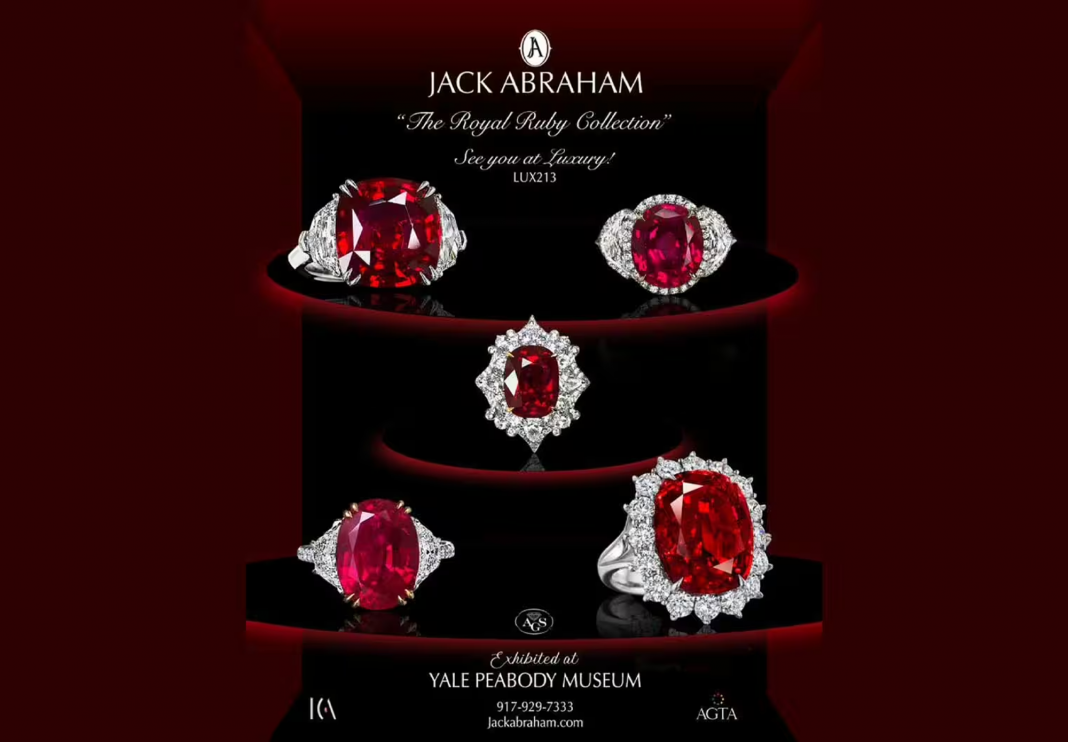At this year’s JCK Luxury show in Las Vegas, one of the most extraordinary gemstone collections in recent memory is capturing attention: a suite of five untreated rubies, each from a different corner of the globe. Curated by veteran jeweler and collector Jack Abraham over the course of 40 years, the “Royal Ruby” collection showcases the exceptional beauty, rarity, and diversity of natural rubies—without enhancement, just as nature created them.
A passion project decades in the making
Jack Abraham, founder of New York-based Jack Abraham–The Precious Collection, has spent nearly five decades in pursuit of one goal: assembling a ruby suite that reflects the unmatched natural beauty of unheated stones from across the globe. The result is the “Royal Ruby” collection, five exceptional rubies—each over 7 carats and from a distinct country—now set into rings and on view at one of the industry’s most prestigious shows.
Altogether weighing more than 50 carats, the collection features a 17.88-carat ruby from Madagascar, a 9.08-carat ruby from Thailand, a 7.11-carat stone from Myanmar (formerly Burma), a 10.99-carat ruby from Mozambique, and an 8.47-carat ruby from Tajikistan. What binds them together isn’t just size or color, but purity—none have undergone the heating processes typically used to enhance color or clarity.
Abraham began his journey in 1979 with a modest 5.79-carat no-heat Thai ruby—just the second ruby he ever acquired under his own company. Over the years, the suite has evolved, as Abraham replaced earlier stones with larger or more visually impressive examples. “Every time I find a stone that is bigger and/or better, I replace it,” he said.
From museum halls to industry floors

While private collectors may lust after the “Royal Ruby” collection, its debut wasn’t on a red carpet or auction stage, but in the hallowed halls of academia. The suite first went on public display at the 2024 reopening of Yale’s Peabody Museum, following a major renovation of its Minerals, Earth, and Space halls.
The connection came through C.R. “Cap” Beesley, the founder of American Gemological Laboratories and head of the Peabody’s gem advisory board, who invited Abraham to share the collection. Beesley praised Abraham in Roskin Gem News Report as one of the museum’s “most prolific and consistent supporters in the gem and jewelry sector.”
Although the rubies were only displayed at Yale for a few months, their impact was lasting. Abraham later exhibited the collection at the 2025 Tucson gem shows, where, he noted, the response was enthusiastic. “A heck of a response,” he emphasized. It was clear these rubies had a magnetic effect on anyone with an appreciation for natural color and global origin stories.
Rare gems from five nations, one unified vision
The true rarity of the “Royal Ruby” collection lies not only in the quality of each stone but in the intentional curation. Most high-end jewelry showcases focus on size or price—but Abraham’s suite speaks to geology, geography, and the story each stone tells.
The Madagascar ruby stuns with its vivid saturation; the Burmese stone carries the prestige of a region long considered the cradle of the world’s finest rubies. Meanwhile, the Thai and Tajikistani rubies reflect emerging markets with unique chromatic signatures. Mozambique, increasingly seen as the modern standard-bearer for ruby sourcing, contributes a deep, robust red that anchors the collection.
Each stone is set into a ring, highlighting its individual presence while emphasizing the unity of the whole. For Abraham, the goal has always been to preserve the suite as a collective display. “The [collection exhibits] nuances of colors and origins,” he said. “Plus, the stones have not been enhanced in any way.” He hopes to see the group kept together, ideally in a museum setting where the public can appreciate the subtleties in color and form.
A living testament to ruby connoisseurship
By Wednesday afternoon—during JCK’s exclusive invitation-only day—Abraham already had serious interest from buyers for three of the stones. Still, he hesitated to break up the collection. “It deserves to be shown somewhere people can see the differences in colors, the secondary and primary hues, and the depths of the colors,” he explained. “The ‘positive’ colors that make it a good red and the ‘negative’ colors that make them a bit less red.”
This comment speaks to Abraham’s deep understanding of what makes a ruby exceptional—not just carat weight or clarity, but chromatic character, origin, and the presence (or absence) of treatments. The “Royal Ruby” collection is not just rare—it’s educational, poetic even, a visual lexicon of ruby excellence.
As collectors, museum curators, and gem lovers wander the luxury booths of JCK Las Vegas, few displays can claim the quiet authority of Abraham’s. His rubies speak for themselves—unheated, unfiltered, and utterly unforgettable.



